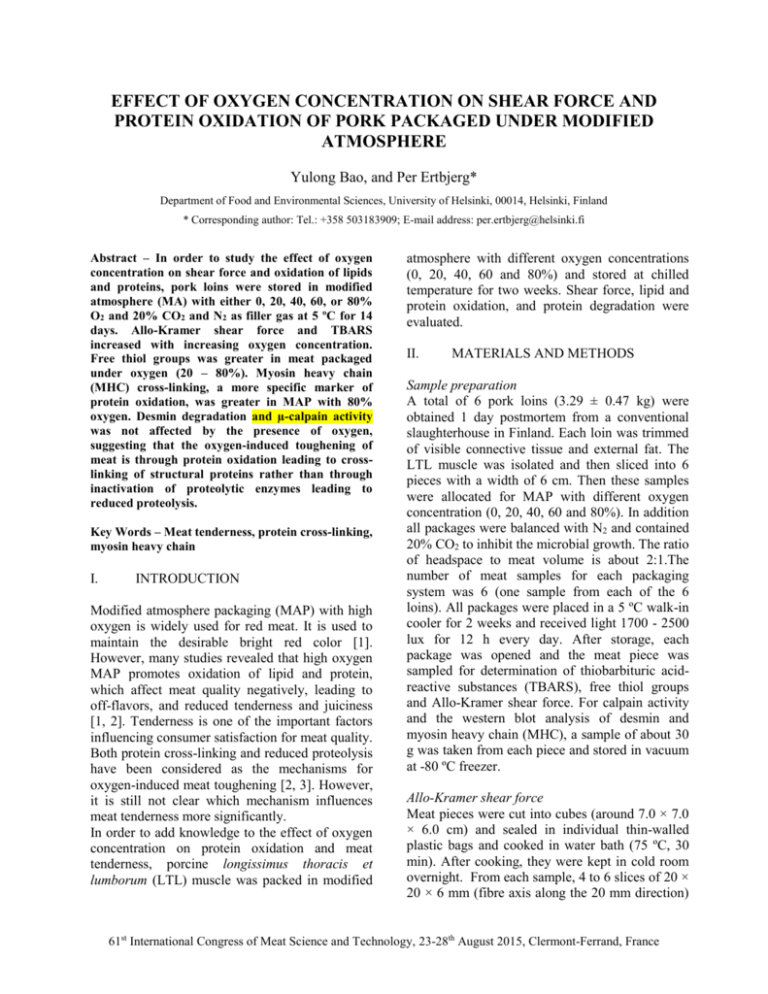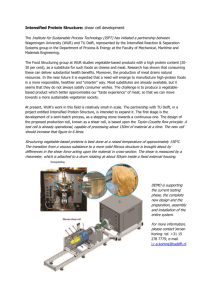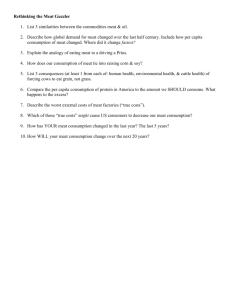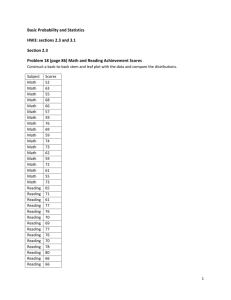format of short papers for the 58th international congress of
advertisement

EFFECT OF OXYGEN CONCENTRATION ON SHEAR FORCE AND PROTEIN OXIDATION OF PORK PACKAGED UNDER MODIFIED ATMOSPHERE Yulong Bao, and Per Ertbjerg* Department of Food and Environmental Sciences, University of Helsinki, 00014, Helsinki, Finland * Corresponding author: Tel.: +358 503183909; E-mail address: per.ertbjerg@helsinki.fi Abstract – In order to study the effect of oxygen concentration on shear force and oxidation of lipids and proteins, pork loins were stored in modified atmosphere (MA) with either 0, 20, 40, 60, or 80% O2 and 20% CO2 and N2 as filler gas at 5 ºC for 14 days. Allo-Kramer shear force and TBARS increased with increasing oxygen concentration. Free thiol groups was greater in meat packaged under oxygen (20 – 80%). Myosin heavy chain (MHC) cross-linking, a more specific marker of protein oxidation, was greater in MAP with 80% oxygen. Desmin degradation and µ-calpain activity was not affected by the presence of oxygen, suggesting that the oxygen-induced toughening of meat is through protein oxidation leading to crosslinking of structural proteins rather than through inactivation of proteolytic enzymes leading to reduced proteolysis. Key Words – Meat tenderness, protein cross-linking, myosin heavy chain I. INTRODUCTION Modified atmosphere packaging (MAP) with high oxygen is widely used for red meat. It is used to maintain the desirable bright red color [1]. However, many studies revealed that high oxygen MAP promotes oxidation of lipid and protein, which affect meat quality negatively, leading to off-flavors, and reduced tenderness and juiciness [1, 2]. Tenderness is one of the important factors influencing consumer satisfaction for meat quality. Both protein cross-linking and reduced proteolysis have been considered as the mechanisms for oxygen-induced meat toughening [2, 3]. However, it is still not clear which mechanism influences meat tenderness more significantly. In order to add knowledge to the effect of oxygen concentration on protein oxidation and meat tenderness, porcine longissimus thoracis et lumborum (LTL) muscle was packed in modified atmosphere with different oxygen concentrations (0, 20, 40, 60 and 80%) and stored at chilled temperature for two weeks. Shear force, lipid and protein oxidation, and protein degradation were evaluated. II. MATERIALS AND METHODS Sample preparation A total of 6 pork loins (3.29 ± 0.47 kg) were obtained 1 day postmortem from a conventional slaughterhouse in Finland. Each loin was trimmed of visible connective tissue and external fat. The LTL muscle was isolated and then sliced into 6 pieces with a width of 6 cm. Then these samples were allocated for MAP with different oxygen concentration (0, 20, 40, 60 and 80%). In addition all packages were balanced with N2 and contained 20% CO2 to inhibit the microbial growth. The ratio of headspace to meat volume is about 2:1.The number of meat samples for each packaging system was 6 (one sample from each of the 6 loins). All packages were placed in a 5 ºC walk-in cooler for 2 weeks and received light 1700 - 2500 lux for 12 h every day. After storage, each package was opened and the meat piece was sampled for determination of thiobarbituric acidreactive substances (TBARS), free thiol groups and Allo-Kramer shear force. For calpain activity and the western blot analysis of desmin and myosin heavy chain (MHC), a sample of about 30 g was taken from each piece and stored in vacuum at -80 ºC freezer. Allo-Kramer shear force Meat pieces were cut into cubes (around 7.0 × 7.0 × 6.0 cm) and sealed in individual thin-walled plastic bags and cooked in water bath (75 ºC, 30 min). After cooking, they were kept in cold room overnight. From each sample, 4 to 6 slices of 20 × 20 × 6 mm (fibre axis along the 20 mm direction) 61st International Congress of Meat Science and Technology, 23-28th August 2015, Clermont-Ferrand, France were cut and weighted. Then each slice was placed in an Allo-Kramer shear cell and cut across the fibre using an Instron Model 6625 (Instron Co, Canton, MA) with a load cell of 5 kN. The result was expressed as N/g. TBARS Muscle sample (5.0 g) was homogenized with 15 mL trichloroacetic acid (5%, w/v) and 0.5 mL butylated hydroxytoluene (4.2% in ethanol, w/v). The homogenization was done by IKA UltraTurrax T25 homogenizer (Labortechnik, Staufen, Germany) at 13500 rpm for 30 s. The slurry was filtered with filter paper (Whatman 40, GE Healthcare), and an aliquot of 2 mL filtrate was mixed with 2 mL thiobarbituric acid (0.02 M) in test tube and incubated at 100 ºC for 40 min. After cooling, absorbance was read at 532 nm. A standard curve of 1,1,3,3-tetraethoxypropane was used to calculate the amount of malondialdehyde (MDA) produced. TBARS content was expressed as mg MDA / kg meat. Thiol groups One gram of meat was homogenized with 25 mL 5% (w/v) SDS in 0.1 M tris-HCl (pH 8.0) at 13500 rpm for 30 s. The homogenates were heated in water bath at 80 ºC for 30 min. After cooling, the homogenates were filtered through filter paper (Whatman 40, GE Healthcare). Protein concentration of the filtrate was determined by reading absorbance at 280 nm and calculated from a standard curve prepepared from 0 to 2 mg/mL bovine serum albumin. Thiol groups were measured by mixing 0.5 mL filtrate, 2 mL of 0.1 M tris-HCl (pH 8.0) and 0.5 mL 10 mM DTNB in 0.1 M tris-HCl (pH 8.0). The mixture was incubated in dark at room temperature for 30 min. Absorbance at 412 nm was recorded and the content of thiol groups were calculated using a standard curve prepared from L-cysteine. The results were expressed as nmol/ mg protein. Western blot against desmin and MHC Frozen samples were thawed and cut into small pieces. Sample filtrates were prepared as for the determination of thiol groups. For gel electrophoresis, NuPAGE (Invitrogen, CA, USA) Novex 12% Bis-Tris gels and 3-8% Tris-Acetate gels were used for desmin and MHC analysis, respectively. For MHC analysis, no reducing agent was added in order to study the protein crosslinking. The amount of protein loaded into each lane was 30 µg. After electrophoresis, proteins in gels were transferred at 30 V for 1 h onto Immobilon-FL Transfer Membrane (Millipore, Bedford, MA). Transfer buffer was prepared from NuPAGE Transfer Buffer (20×) and 10% methanol was added for desmin analysis, while 5% methanol and 0.05% Tween-20 were added for MHC to facilitate transfer of the high molecular weight target proteins. Membranes were probed and quantified according to Liu et al. [4]. Desmin was detected by mouse monoclonal anti-desmin antibody clone DE-R-11 (Santa Cruz, CA, USA) at 1:5000 and MHC was detected by mouse monoclonal anti-myosin (Skeletal, Fast) antibody clone MY-32 (Sigma-Aldrich, Saint Louis, US) at 1:40000. Calpain activity Frozen samples were finely chopped and 1.5 g meat was homogenized at 13500 rpm for 30 s in cold extraction buffer (50 mM Tris, 5 mM EDTA, 10 mM monothioglycerol, pH 8.0). The homogenate was centrifuged at 15,000 g for 30 min at 4 ºC. An aliquot of the supernatant was mixed with glycerol to final concentration 30% and stored at -80 ºC freezer. The activity of calpain is determined by casein zymography as described by Pomponio et al. [5]. Data analysis Data were analyzed by the IBM SPSS Statistics 21 software using general linear model. Packaging atmosphere was included as fixed factor and animal number as random factor. Tukey HSD test was used to find significant differences at a level of P < 0.05. III. RESULTS AND DISCUSSION Allo-Kramer shear force The effect of oxygen concentration in MAP on Allo-Kramer shear force is shown on Fig. 1. After two weeks storage, all the meat samples had lower shear force compared to the 1 day postmortem sample (P < 0.001). For aged samples, the shear force increased (P < 0.001) with increasing oxygen concentration, supporting the view that the oxygen in MAP reduces meat tenderness. 61st International Congress of Meat Science and Technology, 23-28th August 2015, Clermont-Ferrand, France 120 e Allo-Kramer shear force (N/g) 110 d 100 c 90 b b 20 40 80 a 70 60 50 40 F 0 60 80 Fig.1. Allo-Kramer shear force of porcine longissimus thoracis et lumborum (LTL) muscle stored in modified atmosphere with different oxygen concentration (0, 20, 40, 60 and 80%) at 5 ºC for 14 days. F represents 1 day postmortem samples. Means with standard errors (n=6) are shown. a-eMeans with the same letter do not differ (P > 0.05) Oxidation of lipids and proteins TBARS value increased (P < 0.001) with oxygen concentration. The free thiol content decreased after storage in all groups but the remaining free thiol content was higher in 0% oxygen MAP. The presence of oxygen in MAP caused a larger loss of free thiol groups. However, no significant difference was observed among various oxygen concentrations (20% – 80%) (Table 1). A product of cross-linked MHC was found in all groups including at 1 day postmortem (Fig. 2). And the cross-linked MHC can be used as a specific marker for protein oxidation. Table 1. Oxidation of lipids and proteins of porcine longissimus thoracis et lumborum (LTL) muscle stored in modified atmosphere with different oxygen concentration at 5 ºC for 14 days. TBARS (mg MDA /kg meat) Free thiols (nmol/mg protein) Crosslinked MHC* 0 20 0.13a 0.37ab 57.78b 54.08a 5.90a 8.24a 40 60 0.56bc 0.71cd 52.75a 53.03a 9.97ab 8.76ab 80 1.03d 51.28a 16.53b p-value <0.001 <0.001 0.002 *The ratio of cross-linked MHC to the MHC band intensity of 1 day postmortem samples. Means with different superscripts are different (P < 0.05) Fig.2. Representative western blot of myosin heavy chain (MHC) in porcine longissimus thoracis et lumborum (LTL) muscle stored in modified atmosphere with different oxygen concentration (0, 20, 40, 60 and 80%) at 5 ºC for 14 days. F represents 1 day postmortem samples. CL-MHC: cross-linked myosin heavy chain. Mechanisms for oxygen-induced meat toughening µ-calpain is believed to be involved in postmortem meat tenderization. Oxidation of the cysteine residue in the active site of µ-calpain resulted in loss of activity and less proteolysis subsequently [6]. Reduced proteolysis has been suggested as potential mechanism for oxygeninduced meat toughening. However, we did not find any significant effect of oxygen concentration on desmin degradation (Fig.3) and the casein zymography indicates that µ-calpain is not inactivated by the oxygen in MAP (Fig.4). The negative effect of high oxygen MAP on meat tenderness must therefore be caused by other factors than inhibition of postmortem proteolysis. Increased protein cross-linking may contribute to the oxygen-induced meat toughening. In this study, cross-linked MHC was greater in the 80% oxygen MAP compared to 0 and 20% oxygen (Table 1) while shear force is also greater in higher oxygen concentrations. Similarly, Kim et al. [7] reported a significant increase in shear force and greater extent of cross-linked myosin products of lamb loins under high oxygen MAP 61st International Congress of Meat Science and Technology, 23-28th August 2015, Clermont-Ferrand, France compared to oxygen-permeable overwrap-PVC, but no impact of packaging on desmin and troponin-T degradation. Our results suggested the mechanism of oxygen-induced toughening of meat is through protein oxidation leading to cross-linking of structural proteins rather than through inactivation of proteolytic enzymes leading to reduced proteolysis. ACKNOWLEDGEMENTS The authors would like to thank the China Scholarship Council for the financial support and Marita Ruusunen, Jiao Liu, and Timo Holopainen for their help with the project. REFERENCES 1. 2. 3. Fig.3. Representative western blot of desmin in porcine longissimus thoracis et lumborum (LTL) muscle stored in modified atmosphere with different oxygen concentration (0, 20, 40, 60 and 80%) at 5 ºC for 14 days. F represents 1 day postmortem samples. 4. 5. 6. Fig.4. Representative Zymogram showing calpain activity in porcine longissimus thoracis et lumborum (LTL) muscle stored in modified atmosphere with different oxygen concentration (0, 20, 40, 60 and 80%) at 5 ºC for 14 days. F represents 1 day postmortem samples. IV. CONCLUSION 7. McMillin, K. W. (2008). Where is MAP going? A review and future potential of modified atmosphere packaging for meat. Meat Science 80: 43-65. Lund, M. N., Lametsch, R., Hviid, M. S., Jensen, O. N., & Skibsted, L. H. (2007). High-oxygen packaging atmosphere influences protein oxidation and tenderness of porcine longissimus dorsi during chill storage. Meat Science 77: 295-303. Rowe, L. J., Maddock, K. R., Lonergan, S. M., & Huff-Lonergan, E. (2004). Oxidative environments decrease tenderization of beef steaks through inactivation of mu-calpain. Journal of Animal Science 82: 3254-3266. Liu, J., Ruusunen, M., Puolanne, E., & Ertbjerg, P. (2013). Effect of pre-rigor temperature incubation on sarcoplasmic protein solubility, calpain activity and meat properties in porcine muscle. LWT-Food Science and Technology 55: 483-489. Pomponio, L., Lametsch, R., Karlsson, A. H., Costa, L. N., Grossi, A., & Ertbjerg, P. (2008). Evidence for post-mortem m-calpain autolysis in porcine muscle. Meat science 80: 761-764. Lametsch, R., Lonergan, S., & Huff-Lonergan, E. (2008). Disulfide bond within µ-calpain active site inhibits activity and autolysis. Biochimica Et Biophysica Acta (BBA)-Proteins and Proteomics 1784: 1215-1221. Kim, Y. H. B., Bødker, S., & Rosenvold, K. (2012). Influence of lamb age and high-oxygen modified atmosphere packaging on protein polymerization of long-term aged lamb loins. Food Chemistry 135: 122-126. Increased oxygen concentration in MAP resulted in higher shear force and greater TBARS in pork meat. The presence of oxygen caused greater loss of free thiol groups and the MHC cross-linking was greater in MAP with 80% oxygen than 0% and 20% oxygen. Desmin degradation was not affected by different packaging system. These results suggested that the mechanism of oxygeninduced toughening of meat is through protein oxidation leading to cross-links rather than through reduced proteolysis. 61st International Congress of Meat Science and Technology, 23-28th August 2015, Clermont-Ferrand, France








